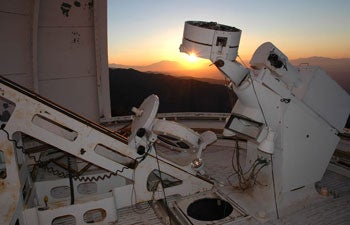Pinkerton Wins Poster Contest
Physics and astronomy Ph.D. student Stephen Pinkerton has won first place in the 2014 American Astronomical Society Solar Physics Division Student (AAS-SPD) Poster Contest.
Pinkerton’s award-winning poster described his efforts to measure the north-south and east-west motions of the gas in the shallow solar interior inward of the Sun’s visible surface layer during solar cycles 22 and 23 using one of the methods of local helioseismology.
In his work, Pinkerton processed observations taken over portions of 22 years at the Mount Wilson Observatory’s 60-Foot Solar Tower. As part of his analysis, Pinkerton had to determine whether or not the image plane of the telescope itself was rotating very slowly during each day. He concluded that the instrumental rotation was much smaller than earlier estimates, if not actually nonexistent.
This was a huge feat since data collected from the tower, which has settled during its more than 100 years atop Mount Wilson in the San Gabriel Mountains, slightly tilting the telescope mirror, may have contained a small error. Pinkerton’s research reprocessed the data to identify the magnitude of the rotation, providing them with the means to discover correct statistics.

A purpose of the paper was to explore the ramifications of a rotating image plane on their anticipated meridional and zonal flow results, seen here. Graphic by Stephen Pinkerton.
“This award means so much to me,” Pinkerton said. “I worked with data produced from Mt. Wilson since 1987. Most of the astronomical community works with data from GONG, HMI or MDI. This has opened up communication and people are becoming more interested in working with results from our Mt. Wilson data study.”
Led by Edward Rhodes, professor in the Department of Physics and Astronomy, USC Dornsife has acquired time series of full-disk Dopplergrams at the 60-Foot Solar Tower each year from 1987 to 2009.
At the tower, Rhodes conducts research with both graduate and undergraduate students, collecting data and studying the sun’s internal structure. Helioseismologist Rhodes and his students examine the sun’s wave oscillations, in a manner similar to that employed by seismologists who monitor waves caused by earthquakes, to learn about the Earth’s interior.
The tower was designed by solar astronomer George Ellery Hale to provide an image plane that did not rotate throughout each observing day. However, preliminary analyses in 2007 of a portion of this archive suggested that the focal plane of the tower might actually be rotating slowly.

Stephen Pinkerton’s research suggests that the alignment of the optics at Mount Wilson Observatory’s 60-Foot Solar Tower has changed only slightly over the years since George Ellery Hale’s time in 1907. Photo by Steve Padilla
If confirmed, Pinkerton’s demonstration that any such instrumental rotation is considerably smaller than those early estimates suggests that the alignment of the optics has changed only slightly over the years since Hale’s time in 1907. This possible rotation of the image plane was uncovered through the computation of subsurface flow maps using the ring-diagram method of local helioseismology.
Some of the initial Mt. Wilson Observatory flow maps appeared to show evidence for a so-called “washing machine” effect similar to the pattern that was seen in the initial GONG flow maps. Rhodes and his team have been working to confirm the early estimates of the focal plane rotation. The purpose of the paper was to report on the status of this endeavor as well as explore the ramifications of a rotating image plane on their anticipated meridional and zonal flow results.
“I’m very happy that Stephen was selected for this honor, since it recognizes both his growing skill as a solar physicist and his ability to explain his complex topic to the judges clearly and concisely,” Rhodes said. “I’m not surprised that Stephen received this award since he has demonstrated an exceptional ability of communicating difficult scientific concepts to non-scientist students while he has served as a teaching assistant here at the university.”

At Mount Wilson Observatory’s 60-Foot Solar Tower, Edward Rhodes conducts research with graduate and undergraduate students, collecting data and studying the sun’s internal structure. Photo by Peter Zhaoyu Zhou.
About 20 entries from throughout the country were judged on readability, flow, quality of appearance and proportion of independent work done by the student. Judges also took into account the oral presentation by the student, how well the conclusions lined up with the aim or purpose and the overall quality of the work.
“Mr. Pinkerton did quite well in all of these categories,” said Kathy Reeves, who oversaw the AAS-SPD Student Poster Contest. “In particular, the judges felt that Mr. Pinkerton did a very good job of describing the work in oral discussions, the poster was well written and it had a very nice appearance.”